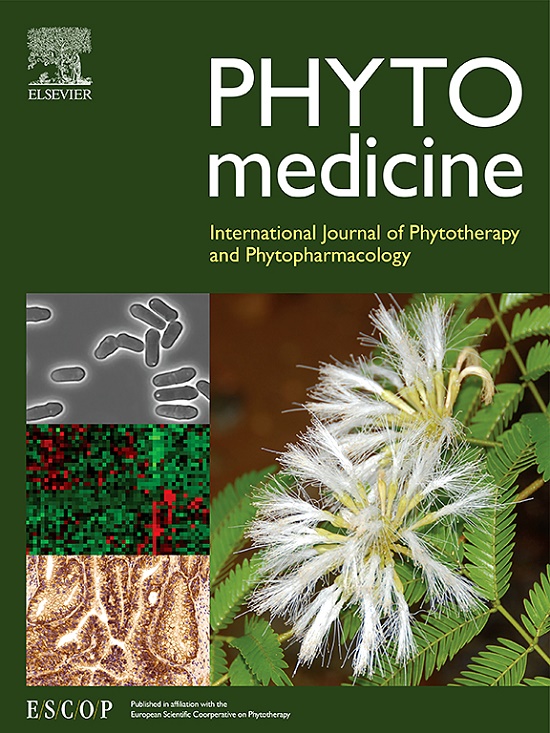将超高效液相色谱-质谱-非活性轨道质谱(UHPLC-Q-Exactive orbitrap HRMS)与血清药理分析相结合研究保甘宁煎剂的抗肝纤维化作用
IF 6.7
1区 医学
Q1 CHEMISTRY, MEDICINAL
引用次数: 0
摘要
背景:肝纤维化(HF)的早期干预对于降低肝硬化相关死亡率和肝细胞癌的风险至关重要。然而,治疗纤维化已被证明更具挑战性,目前尚无批准的抗纤维化治疗方法可用于心衰。中药对心衰的治疗具有重要的潜力。目的:本研究旨在系统探讨保肝宁汤的药理基础,为进一步研究保肝宁的作用靶点和作用机制提供经验依据。研究设计:采用超高效液相色谱-高分辨率质谱联用技术(UPLC-HRMS)对BGN的化学成分进行分析。利用疾病数据库对关键化合物进行研究,预测相关靶点,然后进行分子对接和分子动力学模拟,探索分子水平的相互作用。通过体内和体外实验验证了BGN的有效性和关键靶点。方法:采用超高效液相色谱-高效液相色谱法(UPLC-HRMS)鉴定其化学成分,血清药理学法测定大鼠血浆中有效化学成分。以斑马鱼、HSC-T6细胞、JS-1细胞系和小鼠为实验模型,评价BGN的抗纤维化作用。结果:BGN在体内和体外模型中均有明显的抗纤维化作用。在BGN中共鉴定出757种化合物,检测到18种原型成分和代谢物。三种化合物-丁香酸、胆酸甲酯和3β-羟基-5-胆烯酸对HF表现出剂量依赖性的抑制作用。分子对接研究揭示了这些化合物与预测靶标之间稳定的相互作用。此外,筛选的成分在细胞模型和斑马鱼纤维化模型中均以剂量依赖的方式有效降低了α-SMA和col - 1的表达。结论:对BGN的化学成分及其代谢过程的综合分析为其药理作用提供了有价值的见解。这些发现支持BGN在治疗肝纤维化和改善患者预后方面的潜在临床和国际应用。本文章由计算机程序翻译,如有差异,请以英文原文为准。
Integrated UHPLC-Q-exactive orbitrap HRMS and serum pharmacochemistry for the investigation of anti-hepatic fibrosis effect of Baoganning Decoction
Background
Early intervention in hepatic fibrosis (HF) is critical to reducing the risk of cirrhosis-related mortality and hepatocellular cancer. However, treating fibrosis has proven to be more challenging, with no approved anti-fibrotic therapies currently available for HF. Traditional Chinese medicines (TCMs) hold significant potential for the management of HF.
Purpose
This study aims to propose a systematic approach for investigating the pharmacological basis of Baoganning (BGN) Decoction, providing empirical evidence to support future research on its targets and mechanisms of BGN.
Study design
Ultrahigh-performance liquid chromatography coupled with high- resolution mass spectrometry (UPLC-HRMS) was employed to analyze the chemical composition of BGN. Key compounds were investigated using disease databases to predict relevant targets, followed by molecular docking and molecular dynamics simulations to explore molecular-level interactions. The efficacy and critical targets of BGN were validated through in vivo and in vitro experiments.
Methods
UPLC-HRMS was used to identify the chemical composition of the BGN, and serum pharmacology determined the active chemical constituents in rat plasma. Zebrafish, HSC-T6 cells, JS-1 cell line and mice served as experimental models to evaluate the antifibrotic effects of BGN.
Results
BGN demonstrated significant antifibrotic effect in vivo and in vitro models. A total of 757 compounds were identified in BGN, with 18 prototypical components and metabolites detected. Three compounds-quillaic acid, methyl cholate, and 3β-hydroxy-5-cholenoic exhibited dose-dependent inhibitory effects on HF. Molecular docking studies revealed stable interactions between these compounds and predicted targets. Additionally, the screened components effectively reduced the expression of α-SMA and COL-I in both a cellular model and a zebrafish fibrosis model in a dose-dependent manner.
Conclusion
The comprehensive analysis of BGN's chemical composition and its metabolic processes provides valuable insights into its pharmacological effects. These findings support the potential clinical and international application of BGN in treating hepatic fibrosis and improving patient outcomes.
求助全文
通过发布文献求助,成功后即可免费获取论文全文。
去求助
来源期刊

Phytomedicine
医学-药学
CiteScore
10.30
自引率
5.10%
发文量
670
审稿时长
91 days
期刊介绍:
Phytomedicine is a therapy-oriented journal that publishes innovative studies on the efficacy, safety, quality, and mechanisms of action of specified plant extracts, phytopharmaceuticals, and their isolated constituents. This includes clinical, pharmacological, pharmacokinetic, and toxicological studies of herbal medicinal products, preparations, and purified compounds with defined and consistent quality, ensuring reproducible pharmacological activity. Founded in 1994, Phytomedicine aims to focus and stimulate research in this field and establish internationally accepted scientific standards for pharmacological studies, proof of clinical efficacy, and safety of phytomedicines.
 求助内容:
求助内容: 应助结果提醒方式:
应助结果提醒方式:


